HI5001: Accounting for Business Decisions - Tutorial Questions
VerifiedAdded on 2023/01/10
|12
|2457
|75
Homework Assignment
AI Summary
This assignment delves into key aspects of accounting for business decisions, addressing various tutorial questions. It begins by outlining the process of recording transactions in different accounting books and journals, covering topics like purchases, sales, and payments. The solution includes calculations for cash receipts and payments, along with the preparation of cash at bank ledger accounts and bank reconciliation statements. Furthermore, the assignment explores journal entries, particularly for sales, discounts, and uncollectible accounts, along with their reflection in the balance sheet. The assignment then presents inventory valuation using the FIFO method, accompanied by an income statement analysis. Finally, it demonstrates the calculation of depreciation using straight-line, diminishing balance, and units of production methods, including journal entries and balance sheet presentation for the diminishing balance method. The report concludes by summarizing the importance of accurate accounting for informed business decisions.
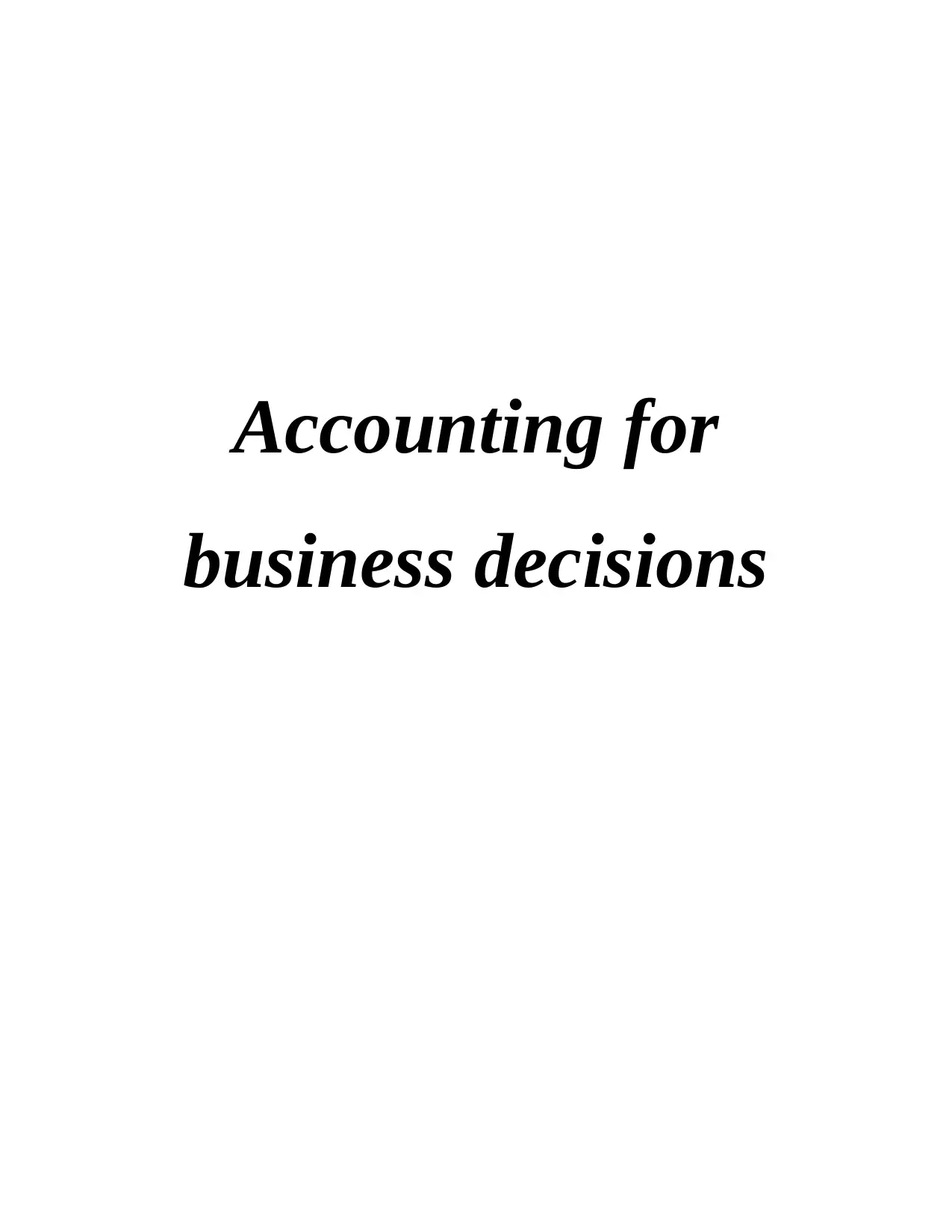
Accounting for
business decisions
business decisions
Paraphrase This Document
Need a fresh take? Get an instant paraphrase of this document with our AI Paraphraser
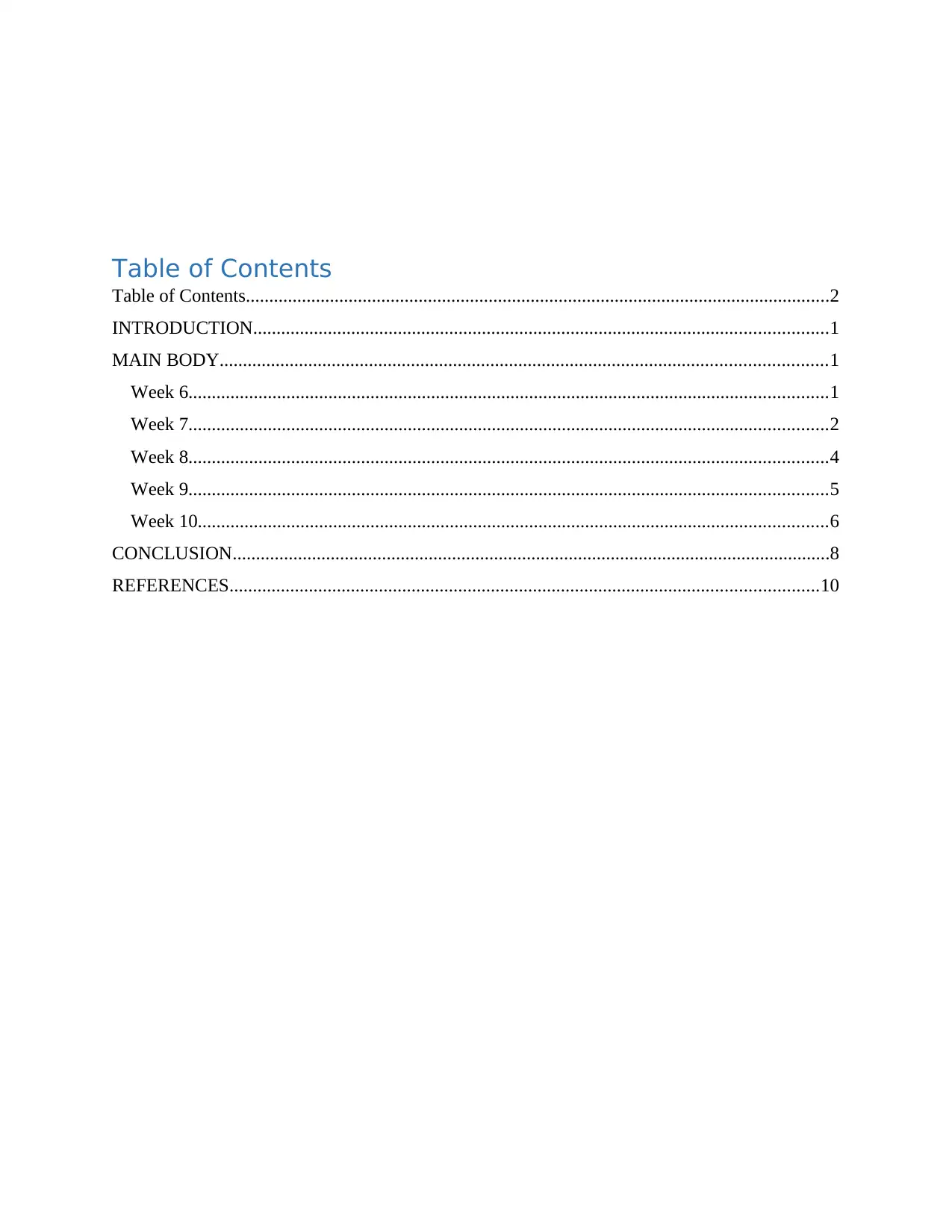
Table of Contents
Table of Contents.............................................................................................................................2
INTRODUCTION...........................................................................................................................1
MAIN BODY..................................................................................................................................1
Week 6.........................................................................................................................................1
Week 7.........................................................................................................................................2
Week 8.........................................................................................................................................4
Week 9.........................................................................................................................................5
Week 10.......................................................................................................................................6
CONCLUSION................................................................................................................................8
REFERENCES..............................................................................................................................10
Table of Contents.............................................................................................................................2
INTRODUCTION...........................................................................................................................1
MAIN BODY..................................................................................................................................1
Week 6.........................................................................................................................................1
Week 7.........................................................................................................................................2
Week 8.........................................................................................................................................4
Week 9.........................................................................................................................................5
Week 10.......................................................................................................................................6
CONCLUSION................................................................................................................................8
REFERENCES..............................................................................................................................10
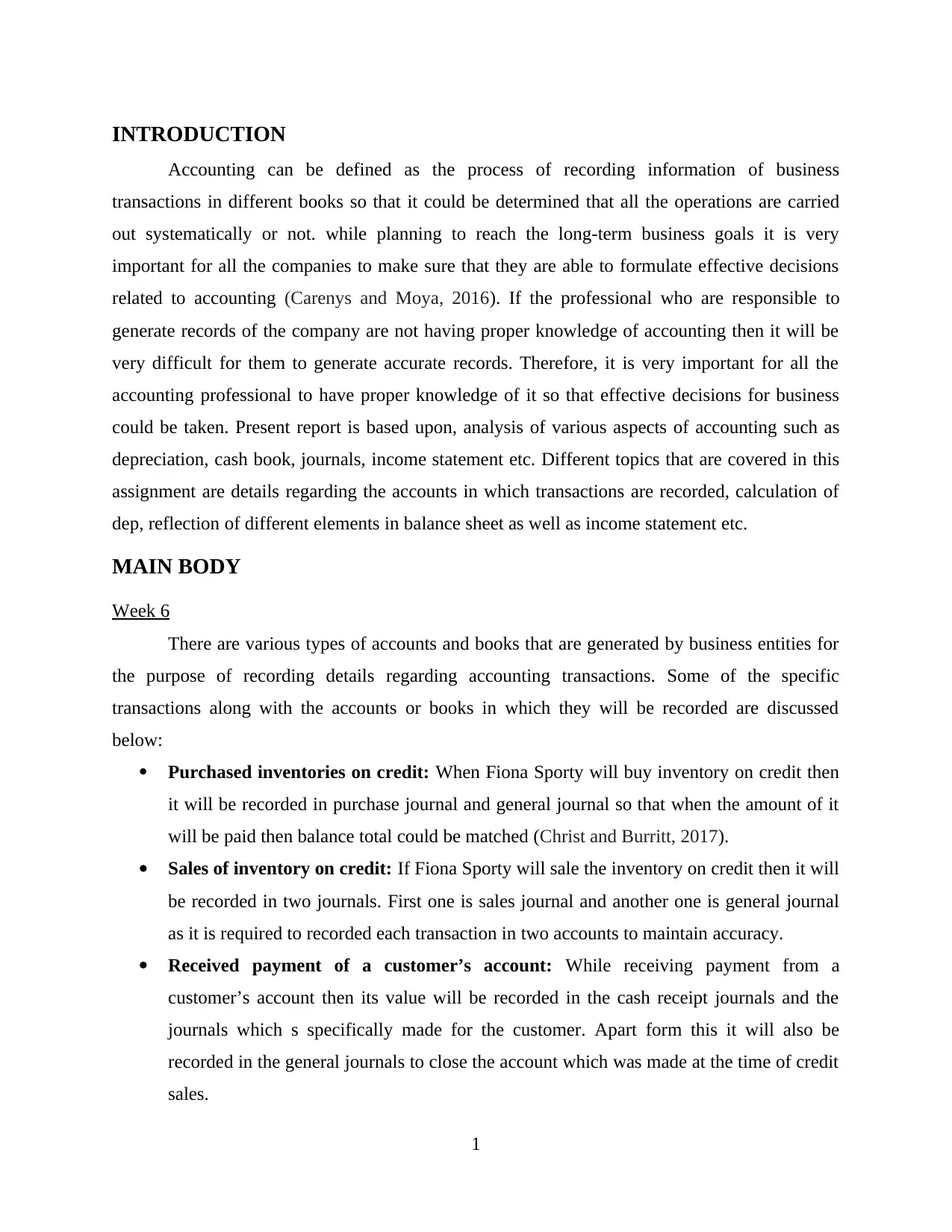
INTRODUCTION
Accounting can be defined as the process of recording information of business
transactions in different books so that it could be determined that all the operations are carried
out systematically or not. while planning to reach the long-term business goals it is very
important for all the companies to make sure that they are able to formulate effective decisions
related to accounting (Carenys and Moya, 2016). If the professional who are responsible to
generate records of the company are not having proper knowledge of accounting then it will be
very difficult for them to generate accurate records. Therefore, it is very important for all the
accounting professional to have proper knowledge of it so that effective decisions for business
could be taken. Present report is based upon, analysis of various aspects of accounting such as
depreciation, cash book, journals, income statement etc. Different topics that are covered in this
assignment are details regarding the accounts in which transactions are recorded, calculation of
dep, reflection of different elements in balance sheet as well as income statement etc.
MAIN BODY
Week 6
There are various types of accounts and books that are generated by business entities for
the purpose of recording details regarding accounting transactions. Some of the specific
transactions along with the accounts or books in which they will be recorded are discussed
below:
Purchased inventories on credit: When Fiona Sporty will buy inventory on credit then
it will be recorded in purchase journal and general journal so that when the amount of it
will be paid then balance total could be matched (Christ and Burritt, 2017).
Sales of inventory on credit: If Fiona Sporty will sale the inventory on credit then it will
be recorded in two journals. First one is sales journal and another one is general journal
as it is required to recorded each transaction in two accounts to maintain accuracy.
Received payment of a customer’s account: While receiving payment from a
customer’s account then its value will be recorded in the cash receipt journals and the
journals which s specifically made for the customer. Apart form this it will also be
recorded in the general journals to close the account which was made at the time of credit
sales.
1
Accounting can be defined as the process of recording information of business
transactions in different books so that it could be determined that all the operations are carried
out systematically or not. while planning to reach the long-term business goals it is very
important for all the companies to make sure that they are able to formulate effective decisions
related to accounting (Carenys and Moya, 2016). If the professional who are responsible to
generate records of the company are not having proper knowledge of accounting then it will be
very difficult for them to generate accurate records. Therefore, it is very important for all the
accounting professional to have proper knowledge of it so that effective decisions for business
could be taken. Present report is based upon, analysis of various aspects of accounting such as
depreciation, cash book, journals, income statement etc. Different topics that are covered in this
assignment are details regarding the accounts in which transactions are recorded, calculation of
dep, reflection of different elements in balance sheet as well as income statement etc.
MAIN BODY
Week 6
There are various types of accounts and books that are generated by business entities for
the purpose of recording details regarding accounting transactions. Some of the specific
transactions along with the accounts or books in which they will be recorded are discussed
below:
Purchased inventories on credit: When Fiona Sporty will buy inventory on credit then
it will be recorded in purchase journal and general journal so that when the amount of it
will be paid then balance total could be matched (Christ and Burritt, 2017).
Sales of inventory on credit: If Fiona Sporty will sale the inventory on credit then it will
be recorded in two journals. First one is sales journal and another one is general journal
as it is required to recorded each transaction in two accounts to maintain accuracy.
Received payment of a customer’s account: While receiving payment from a
customer’s account then its value will be recorded in the cash receipt journals and the
journals which s specifically made for the customer. Apart form this it will also be
recorded in the general journals to close the account which was made at the time of credit
sales.
1
⊘ This is a preview!⊘
Do you want full access?
Subscribe today to unlock all pages.

Trusted by 1+ million students worldwide

Payment of monthly rent by cheque: The amount which will be paid by Fiona Sporty
through this transaction will be recorded in cash payment journal and the general journals
as the information of expenses is recorded in this book (Christ and Burritt, 2018).
End of period closing entries: All the end of period entries are made in all the journals
so that their closing balance could be determined and it could be recorded in trial balance
in order to prepare final accounts to analyse financial position of business.
Week 7
(a) Calculate cash receipts and cash payments for the month of june:
Cash Receipt:
This is an money of a company which they receives for services or goods to give us all
the total amount of funds they have at our disposal, they add the cash receipts to the bottom
balance. It is a written statement that a business creates when organization earns money through
sale of products or services.
Cash Receipt Journal
Date Particular Amount
June 30 Progress, total $ 292,704
Less: Dishonored Check $ (136)
Electronic Transfer $ 644
Interest Revenue $ 44
Total $ 293,256
Cash Payment:
A cash payment seems to be expenses which paid out to the provider by the receiver of
goods or services. It could also involve paying employees within a business in remuneration for
everyone’s hours of work or repaying them for minor expenses which are too low to be
redirected through to the accounts receivable system. Cash payments are favored for those
people who do not have a savings account or who want to avoid disclosing a tax obligation on
income.
Cash Payment Journal
Date Particular Amount
June 30 Progress, total $ 265,074
2
through this transaction will be recorded in cash payment journal and the general journals
as the information of expenses is recorded in this book (Christ and Burritt, 2018).
End of period closing entries: All the end of period entries are made in all the journals
so that their closing balance could be determined and it could be recorded in trial balance
in order to prepare final accounts to analyse financial position of business.
Week 7
(a) Calculate cash receipts and cash payments for the month of june:
Cash Receipt:
This is an money of a company which they receives for services or goods to give us all
the total amount of funds they have at our disposal, they add the cash receipts to the bottom
balance. It is a written statement that a business creates when organization earns money through
sale of products or services.
Cash Receipt Journal
Date Particular Amount
June 30 Progress, total $ 292,704
Less: Dishonored Check $ (136)
Electronic Transfer $ 644
Interest Revenue $ 44
Total $ 293,256
Cash Payment:
A cash payment seems to be expenses which paid out to the provider by the receiver of
goods or services. It could also involve paying employees within a business in remuneration for
everyone’s hours of work or repaying them for minor expenses which are too low to be
redirected through to the accounts receivable system. Cash payments are favored for those
people who do not have a savings account or who want to avoid disclosing a tax obligation on
income.
Cash Payment Journal
Date Particular Amount
June 30 Progress, total $ 265,074
2
Paraphrase This Document
Need a fresh take? Get an instant paraphrase of this document with our AI Paraphraser
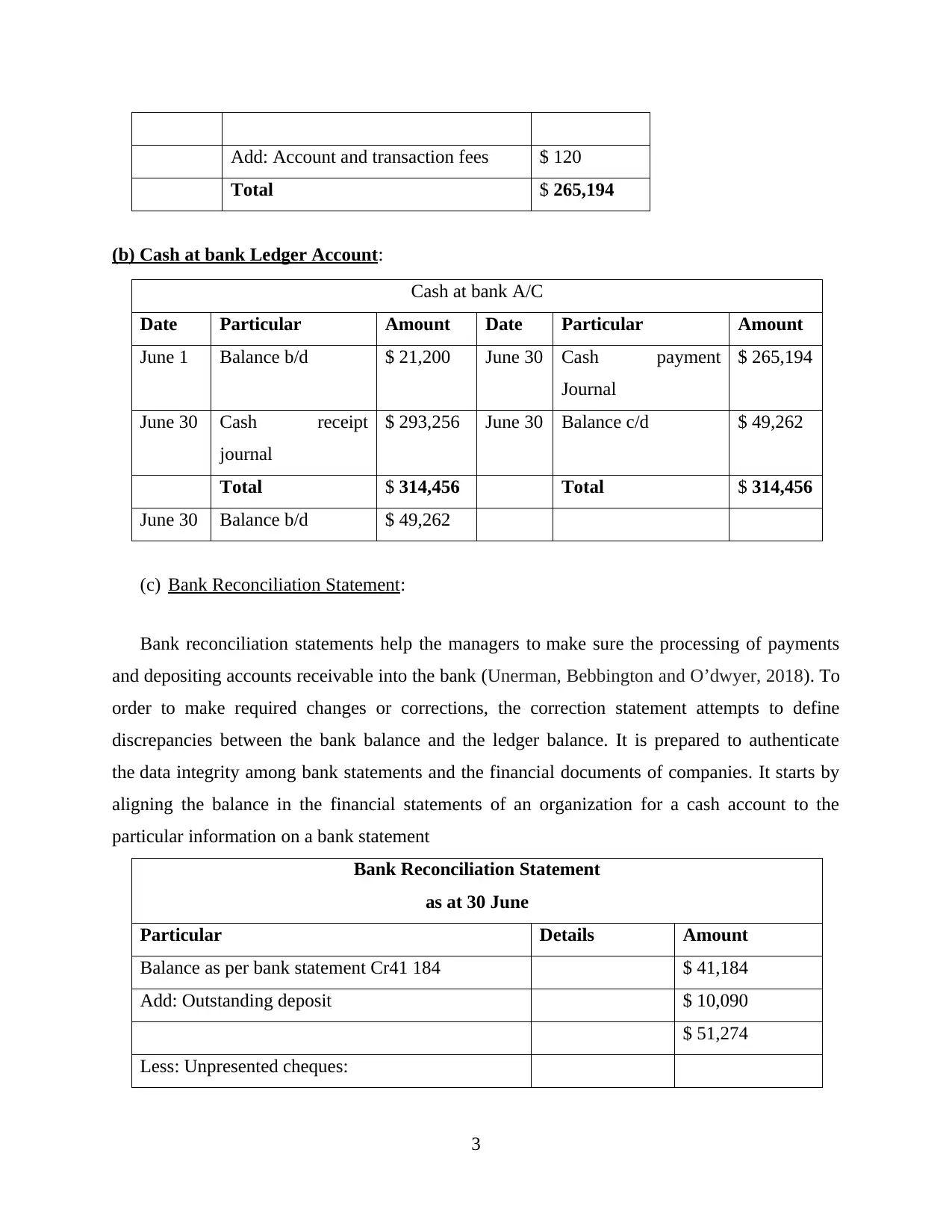
Add: Account and transaction fees $ 120
Total $ 265,194
(b) Cash at bank Ledger Account:
Cash at bank A/C
Date Particular Amount Date Particular Amount
June 1 Balance b/d $ 21,200 June 30 Cash payment
Journal
$ 265,194
June 30 Cash receipt
journal
$ 293,256 June 30 Balance c/d $ 49,262
Total $ 314,456 Total $ 314,456
June 30 Balance b/d $ 49,262
(c) Bank Reconciliation Statement:
Bank reconciliation statements help the managers to make sure the processing of payments
and depositing accounts receivable into the bank (Unerman, Bebbington and O’dwyer, 2018). To
order to make required changes or corrections, the correction statement attempts to define
discrepancies between the bank balance and the ledger balance. It is prepared to authenticate
the data integrity among bank statements and the financial documents of companies. It starts by
aligning the balance in the financial statements of an organization for a cash account to the
particular information on a bank statement
Bank Reconciliation Statement
as at 30 June
Particular Details Amount
Balance as per bank statement Cr41 184 $ 41,184
Add: Outstanding deposit $ 10,090
$ 51,274
Less: Unpresented cheques:
3
Total $ 265,194
(b) Cash at bank Ledger Account:
Cash at bank A/C
Date Particular Amount Date Particular Amount
June 1 Balance b/d $ 21,200 June 30 Cash payment
Journal
$ 265,194
June 30 Cash receipt
journal
$ 293,256 June 30 Balance c/d $ 49,262
Total $ 314,456 Total $ 314,456
June 30 Balance b/d $ 49,262
(c) Bank Reconciliation Statement:
Bank reconciliation statements help the managers to make sure the processing of payments
and depositing accounts receivable into the bank (Unerman, Bebbington and O’dwyer, 2018). To
order to make required changes or corrections, the correction statement attempts to define
discrepancies between the bank balance and the ledger balance. It is prepared to authenticate
the data integrity among bank statements and the financial documents of companies. It starts by
aligning the balance in the financial statements of an organization for a cash account to the
particular information on a bank statement
Bank Reconciliation Statement
as at 30 June
Particular Details Amount
Balance as per bank statement Cr41 184 $ 41,184
Add: Outstanding deposit $ 10,090
$ 51,274
Less: Unpresented cheques:
3

no. 3456
no. 3457
no. 3460
no. 3462
1,448
84
70
410 $ 2012
Balance as per Cash at Bank account Dr $ 49,262
(d) Amount of cash:
The amount which is to be reported to the balance sheet at the end of June 30 in the balance
sheet is Cash at Bank account $ 49,262. It is mentioned in the assets side of balance sheet under
current assets heading.
Week 8
Journal entries:
Particulars Dr. Cr.
Account receivable a/c Dr. 1195000
To sales a/c 1195000
Sales return a/c Dr. 24100
To Account receivable a/c 24100
Cash a/c Dr. 1400000
Discount a/c Dr. 620455
To account receivables a/c 2020455
Uncollectible accounts a/c Dr. 15851
To Profit and loss a/c 15851
Provision for doubtful debts a/c Dr. 1400
To Profit and loss a/c 1400
Balance sheet:
Liabilities amount Assets Amount
4
no. 3457
no. 3460
no. 3462
1,448
84
70
410 $ 2012
Balance as per Cash at Bank account Dr $ 49,262
(d) Amount of cash:
The amount which is to be reported to the balance sheet at the end of June 30 in the balance
sheet is Cash at Bank account $ 49,262. It is mentioned in the assets side of balance sheet under
current assets heading.
Week 8
Journal entries:
Particulars Dr. Cr.
Account receivable a/c Dr. 1195000
To sales a/c 1195000
Sales return a/c Dr. 24100
To Account receivable a/c 24100
Cash a/c Dr. 1400000
Discount a/c Dr. 620455
To account receivables a/c 2020455
Uncollectible accounts a/c Dr. 15851
To Profit and loss a/c 15851
Provision for doubtful debts a/c Dr. 1400
To Profit and loss a/c 1400
Balance sheet:
Liabilities amount Assets Amount
4
⊘ This is a preview!⊘
Do you want full access?
Subscribe today to unlock all pages.

Trusted by 1+ million students worldwide

Current liabilities: Current assets:
Provision for doubtful
debts
13500 Account receivables 2020455
Journal entry:
Particulars Dr. Cr.
Uncollectible receivables a/c Dr. 2400
To Kim Ltd a/c 2400
Cash a/c Dr. 2400
To uncollectible receivables recovered a/c 2400
Week 9
FIFO method: When all the inventory which is purchased earlier used for sales activities
first then this method is used by entities (Hossain, Chapple and Monroe, 2018). Calculations of it
are as follows:
Date
Purchase Sold Balance
Units Cost Amount Units Cost Amount Units Cost Amount
01-Jun 6100 2.2 13420
04-Jun 4600 2.25 10350 4600 2.25 10350
Closing balance 10700 23770
09-Jun 4100 5 20500 2000 2.2 4400
Closing balance 4600 2.25 10350
6600 14750
12-Jun 4100 2.4 9840 4100 2.4 9840
Closing balance 10700 24590
21-Jun 2000 5 10000 600 2.25 1350
4000 5 20000 4100 2.4 9840
Closing balance 4700 11190
26-Jun 3100 2.5 7750 3100 2.5 7750
Closing balance 7800 18940
Income statement:
Particulars Amount Particulars Amount
Opening inventory 13420 Sales
Purchase (4100 * 5)
5
Provision for doubtful
debts
13500 Account receivables 2020455
Journal entry:
Particulars Dr. Cr.
Uncollectible receivables a/c Dr. 2400
To Kim Ltd a/c 2400
Cash a/c Dr. 2400
To uncollectible receivables recovered a/c 2400
Week 9
FIFO method: When all the inventory which is purchased earlier used for sales activities
first then this method is used by entities (Hossain, Chapple and Monroe, 2018). Calculations of it
are as follows:
Date
Purchase Sold Balance
Units Cost Amount Units Cost Amount Units Cost Amount
01-Jun 6100 2.2 13420
04-Jun 4600 2.25 10350 4600 2.25 10350
Closing balance 10700 23770
09-Jun 4100 5 20500 2000 2.2 4400
Closing balance 4600 2.25 10350
6600 14750
12-Jun 4100 2.4 9840 4100 2.4 9840
Closing balance 10700 24590
21-Jun 2000 5 10000 600 2.25 1350
4000 5 20000 4100 2.4 9840
Closing balance 4700 11190
26-Jun 3100 2.5 7750 3100 2.5 7750
Closing balance 7800 18940
Income statement:
Particulars Amount Particulars Amount
Opening inventory 13420 Sales
Purchase (4100 * 5)
5
Paraphrase This Document
Need a fresh take? Get an instant paraphrase of this document with our AI Paraphraser
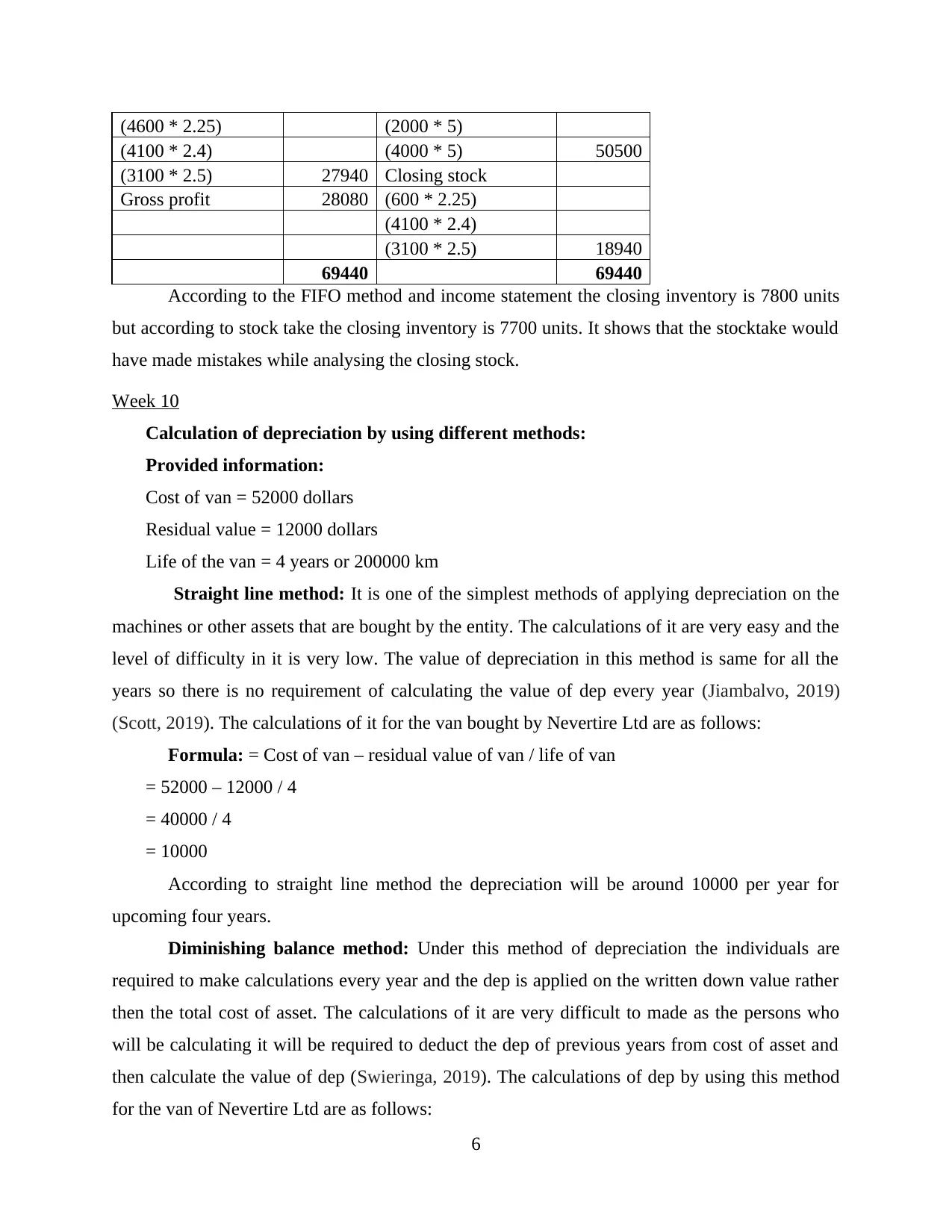
(4600 * 2.25) (2000 * 5)
(4100 * 2.4) (4000 * 5) 50500
(3100 * 2.5) 27940 Closing stock
Gross profit 28080 (600 * 2.25)
(4100 * 2.4)
(3100 * 2.5) 18940
69440 69440
According to the FIFO method and income statement the closing inventory is 7800 units
but according to stock take the closing inventory is 7700 units. It shows that the stocktake would
have made mistakes while analysing the closing stock.
Week 10
Calculation of depreciation by using different methods:
Provided information:
Cost of van = 52000 dollars
Residual value = 12000 dollars
Life of the van = 4 years or 200000 km
Straight line method: It is one of the simplest methods of applying depreciation on the
machines or other assets that are bought by the entity. The calculations of it are very easy and the
level of difficulty in it is very low. The value of depreciation in this method is same for all the
years so there is no requirement of calculating the value of dep every year (Jiambalvo, 2019)
(Scott, 2019). The calculations of it for the van bought by Nevertire Ltd are as follows:
Formula: = Cost of van – residual value of van / life of van
= 52000 – 12000 / 4
= 40000 / 4
= 10000
According to straight line method the depreciation will be around 10000 per year for
upcoming four years.
Diminishing balance method: Under this method of depreciation the individuals are
required to make calculations every year and the dep is applied on the written down value rather
then the total cost of asset. The calculations of it are very difficult to made as the persons who
will be calculating it will be required to deduct the dep of previous years from cost of asset and
then calculate the value of dep (Swieringa, 2019). The calculations of dep by using this method
for the van of Nevertire Ltd are as follows:
6
(4100 * 2.4) (4000 * 5) 50500
(3100 * 2.5) 27940 Closing stock
Gross profit 28080 (600 * 2.25)
(4100 * 2.4)
(3100 * 2.5) 18940
69440 69440
According to the FIFO method and income statement the closing inventory is 7800 units
but according to stock take the closing inventory is 7700 units. It shows that the stocktake would
have made mistakes while analysing the closing stock.
Week 10
Calculation of depreciation by using different methods:
Provided information:
Cost of van = 52000 dollars
Residual value = 12000 dollars
Life of the van = 4 years or 200000 km
Straight line method: It is one of the simplest methods of applying depreciation on the
machines or other assets that are bought by the entity. The calculations of it are very easy and the
level of difficulty in it is very low. The value of depreciation in this method is same for all the
years so there is no requirement of calculating the value of dep every year (Jiambalvo, 2019)
(Scott, 2019). The calculations of it for the van bought by Nevertire Ltd are as follows:
Formula: = Cost of van – residual value of van / life of van
= 52000 – 12000 / 4
= 40000 / 4
= 10000
According to straight line method the depreciation will be around 10000 per year for
upcoming four years.
Diminishing balance method: Under this method of depreciation the individuals are
required to make calculations every year and the dep is applied on the written down value rather
then the total cost of asset. The calculations of it are very difficult to made as the persons who
will be calculating it will be required to deduct the dep of previous years from cost of asset and
then calculate the value of dep (Swieringa, 2019). The calculations of dep by using this method
for the van of Nevertire Ltd are as follows:
6
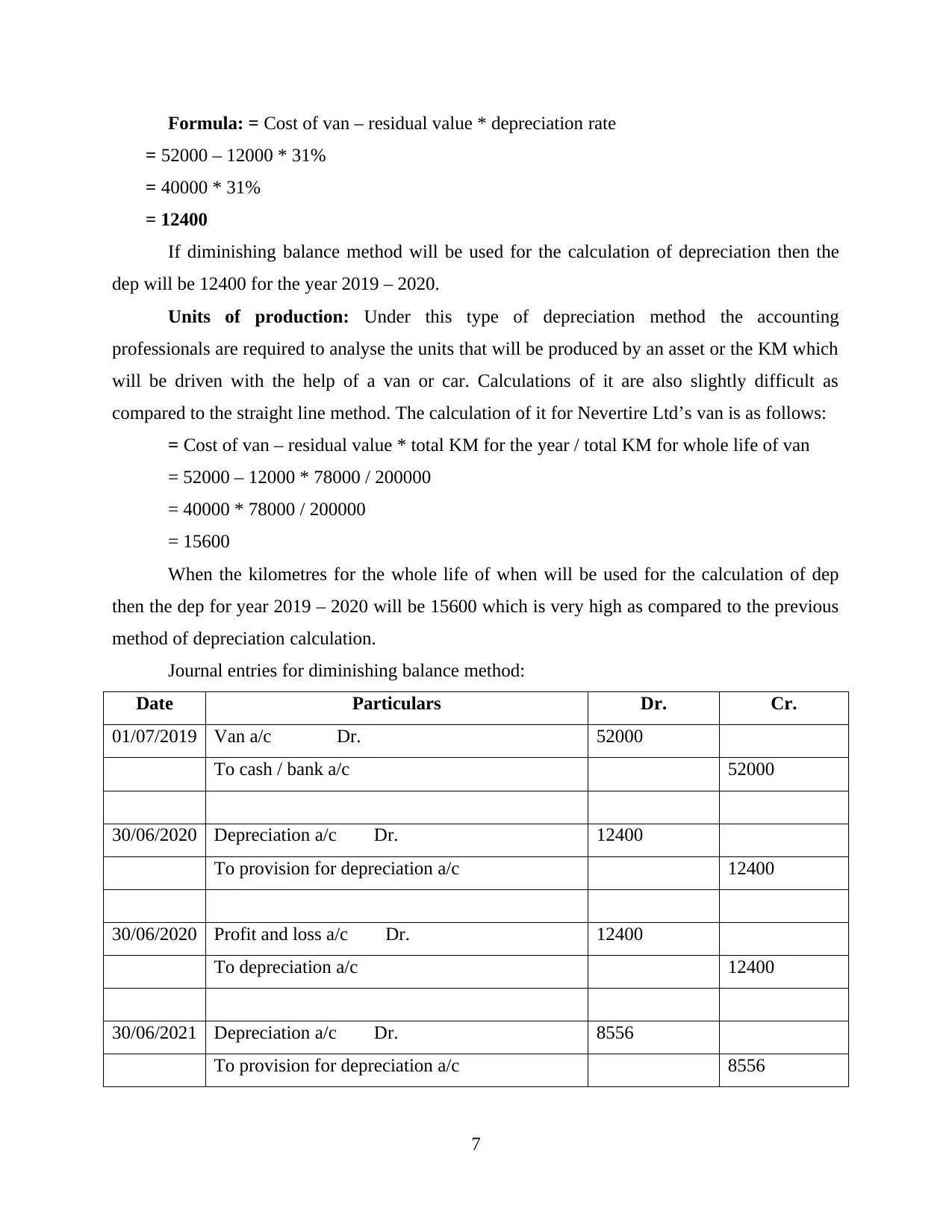
Formula: = Cost of van – residual value * depreciation rate
= 52000 – 12000 * 31%
= 40000 * 31%
= 12400
If diminishing balance method will be used for the calculation of depreciation then the
dep will be 12400 for the year 2019 – 2020.
Units of production: Under this type of depreciation method the accounting
professionals are required to analyse the units that will be produced by an asset or the KM which
will be driven with the help of a van or car. Calculations of it are also slightly difficult as
compared to the straight line method. The calculation of it for Nevertire Ltd’s van is as follows:
= Cost of van – residual value * total KM for the year / total KM for whole life of van
= 52000 – 12000 * 78000 / 200000
= 40000 * 78000 / 200000
= 15600
When the kilometres for the whole life of when will be used for the calculation of dep
then the dep for year 2019 – 2020 will be 15600 which is very high as compared to the previous
method of depreciation calculation.
Journal entries for diminishing balance method:
Date Particulars Dr. Cr.
01/07/2019 Van a/c Dr. 52000
To cash / bank a/c 52000
30/06/2020 Depreciation a/c Dr. 12400
To provision for depreciation a/c 12400
30/06/2020 Profit and loss a/c Dr. 12400
To depreciation a/c 12400
30/06/2021 Depreciation a/c Dr. 8556
To provision for depreciation a/c 8556
7
= 52000 – 12000 * 31%
= 40000 * 31%
= 12400
If diminishing balance method will be used for the calculation of depreciation then the
dep will be 12400 for the year 2019 – 2020.
Units of production: Under this type of depreciation method the accounting
professionals are required to analyse the units that will be produced by an asset or the KM which
will be driven with the help of a van or car. Calculations of it are also slightly difficult as
compared to the straight line method. The calculation of it for Nevertire Ltd’s van is as follows:
= Cost of van – residual value * total KM for the year / total KM for whole life of van
= 52000 – 12000 * 78000 / 200000
= 40000 * 78000 / 200000
= 15600
When the kilometres for the whole life of when will be used for the calculation of dep
then the dep for year 2019 – 2020 will be 15600 which is very high as compared to the previous
method of depreciation calculation.
Journal entries for diminishing balance method:
Date Particulars Dr. Cr.
01/07/2019 Van a/c Dr. 52000
To cash / bank a/c 52000
30/06/2020 Depreciation a/c Dr. 12400
To provision for depreciation a/c 12400
30/06/2020 Profit and loss a/c Dr. 12400
To depreciation a/c 12400
30/06/2021 Depreciation a/c Dr. 8556
To provision for depreciation a/c 8556
7
⊘ This is a preview!⊘
Do you want full access?
Subscribe today to unlock all pages.

Trusted by 1+ million students worldwide
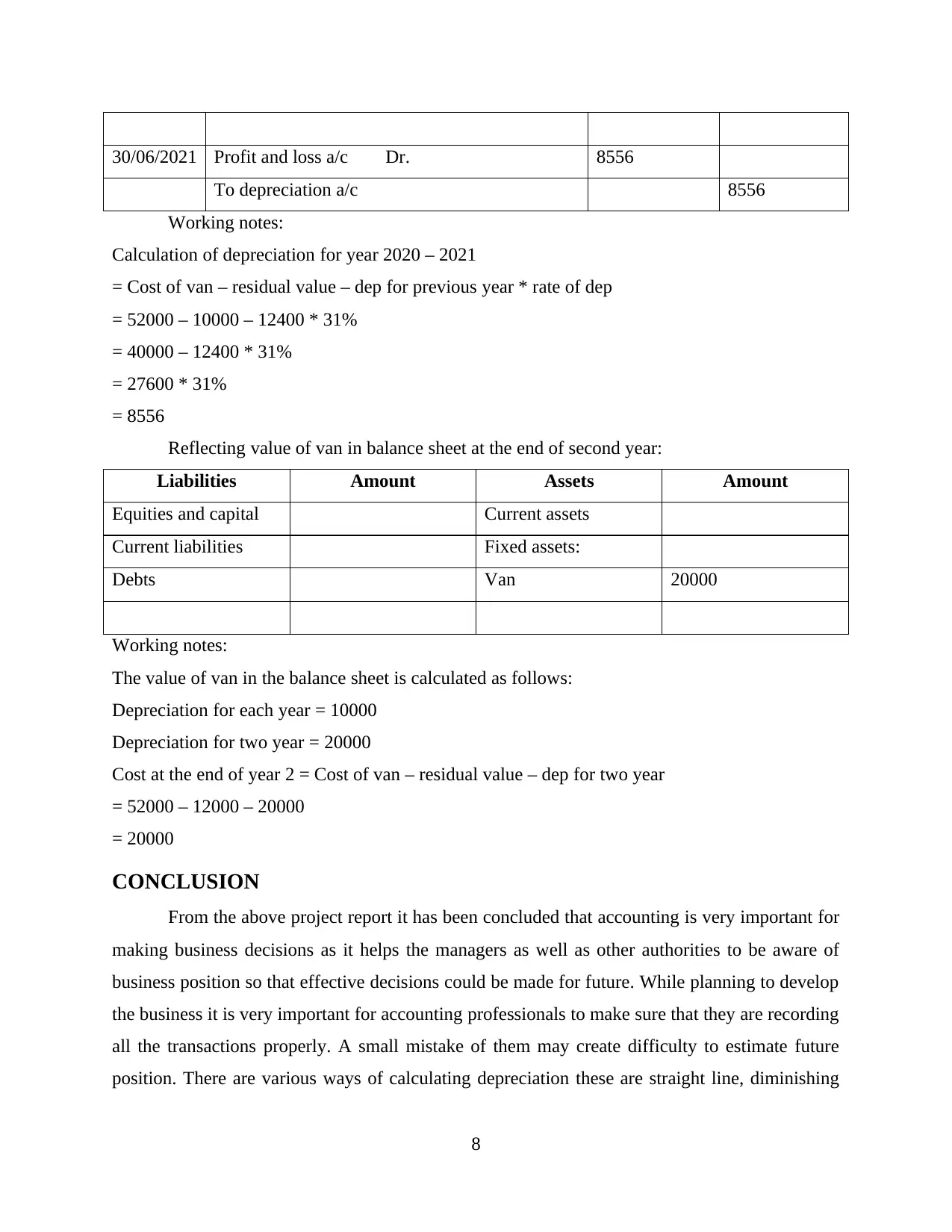
30/06/2021 Profit and loss a/c Dr. 8556
To depreciation a/c 8556
Working notes:
Calculation of depreciation for year 2020 – 2021
= Cost of van – residual value – dep for previous year * rate of dep
= 52000 – 10000 – 12400 * 31%
= 40000 – 12400 * 31%
= 27600 * 31%
= 8556
Reflecting value of van in balance sheet at the end of second year:
Liabilities Amount Assets Amount
Equities and capital Current assets
Current liabilities Fixed assets:
Debts Van 20000
Working notes:
The value of van in the balance sheet is calculated as follows:
Depreciation for each year = 10000
Depreciation for two year = 20000
Cost at the end of year 2 = Cost of van – residual value – dep for two year
= 52000 – 12000 – 20000
= 20000
CONCLUSION
From the above project report it has been concluded that accounting is very important for
making business decisions as it helps the managers as well as other authorities to be aware of
business position so that effective decisions could be made for future. While planning to develop
the business it is very important for accounting professionals to make sure that they are recording
all the transactions properly. A small mistake of them may create difficulty to estimate future
position. There are various ways of calculating depreciation these are straight line, diminishing
8
To depreciation a/c 8556
Working notes:
Calculation of depreciation for year 2020 – 2021
= Cost of van – residual value – dep for previous year * rate of dep
= 52000 – 10000 – 12400 * 31%
= 40000 – 12400 * 31%
= 27600 * 31%
= 8556
Reflecting value of van in balance sheet at the end of second year:
Liabilities Amount Assets Amount
Equities and capital Current assets
Current liabilities Fixed assets:
Debts Van 20000
Working notes:
The value of van in the balance sheet is calculated as follows:
Depreciation for each year = 10000
Depreciation for two year = 20000
Cost at the end of year 2 = Cost of van – residual value – dep for two year
= 52000 – 12000 – 20000
= 20000
CONCLUSION
From the above project report it has been concluded that accounting is very important for
making business decisions as it helps the managers as well as other authorities to be aware of
business position so that effective decisions could be made for future. While planning to develop
the business it is very important for accounting professionals to make sure that they are recording
all the transactions properly. A small mistake of them may create difficulty to estimate future
position. There are various ways of calculating depreciation these are straight line, diminishing
8
Paraphrase This Document
Need a fresh take? Get an instant paraphrase of this document with our AI Paraphraser

balance and units of production method. Any one of them could be used by entities according to
their choice. In order to record the details of stock transactions different methods such as LIFO,
FIFO, Average cost method etc. could be used.
9
their choice. In order to record the details of stock transactions different methods such as LIFO,
FIFO, Average cost method etc. could be used.
9
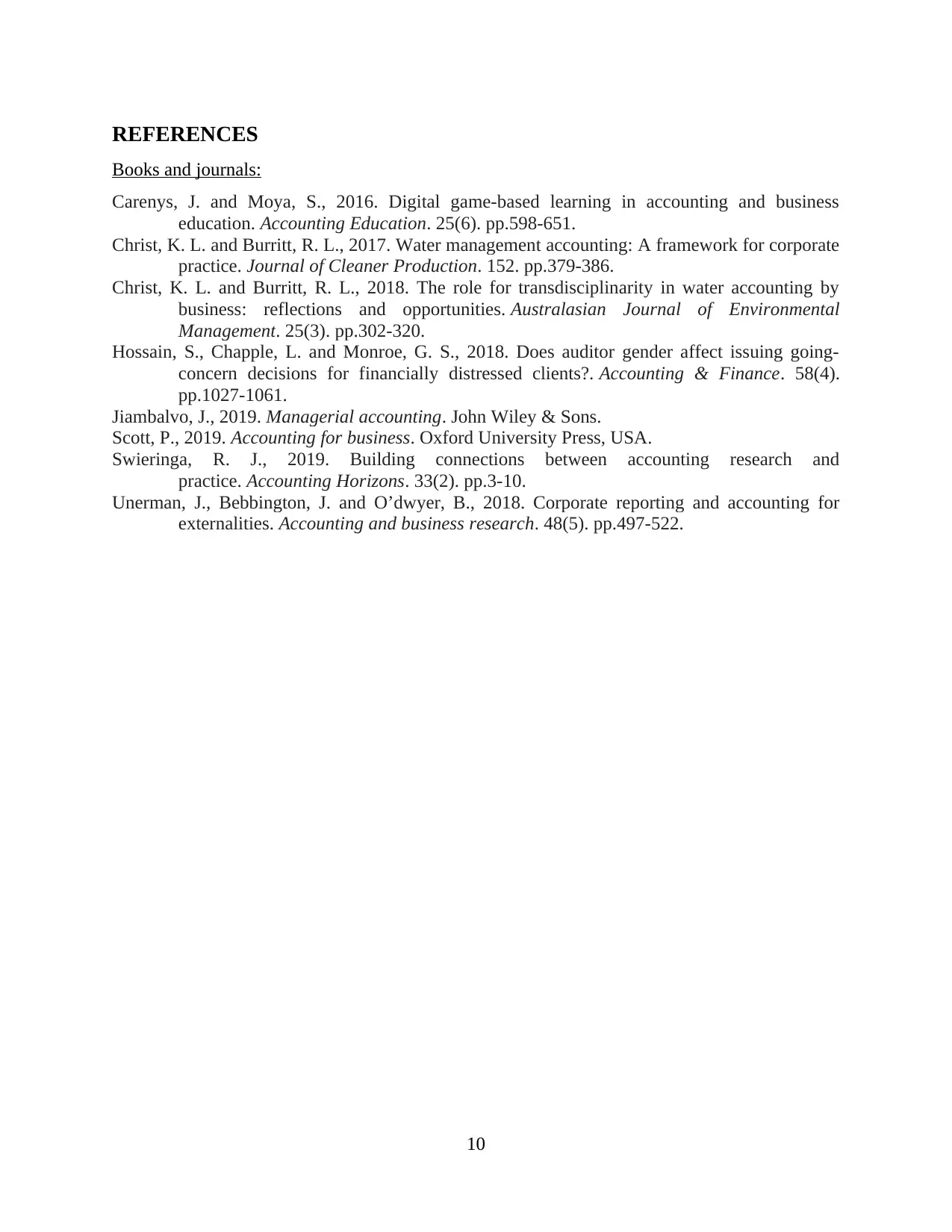
REFERENCES
Books and journals:
Carenys, J. and Moya, S., 2016. Digital game-based learning in accounting and business
education. Accounting Education. 25(6). pp.598-651.
Christ, K. L. and Burritt, R. L., 2017. Water management accounting: A framework for corporate
practice. Journal of Cleaner Production. 152. pp.379-386.
Christ, K. L. and Burritt, R. L., 2018. The role for transdisciplinarity in water accounting by
business: reflections and opportunities. Australasian Journal of Environmental
Management. 25(3). pp.302-320.
Hossain, S., Chapple, L. and Monroe, G. S., 2018. Does auditor gender affect issuing going‐
concern decisions for financially distressed clients?. Accounting & Finance. 58(4).
pp.1027-1061.
Jiambalvo, J., 2019. Managerial accounting. John Wiley & Sons.
Scott, P., 2019. Accounting for business. Oxford University Press, USA.
Swieringa, R. J., 2019. Building connections between accounting research and
practice. Accounting Horizons. 33(2). pp.3-10.
Unerman, J., Bebbington, J. and O’dwyer, B., 2018. Corporate reporting and accounting for
externalities. Accounting and business research. 48(5). pp.497-522.
10
Books and journals:
Carenys, J. and Moya, S., 2016. Digital game-based learning in accounting and business
education. Accounting Education. 25(6). pp.598-651.
Christ, K. L. and Burritt, R. L., 2017. Water management accounting: A framework for corporate
practice. Journal of Cleaner Production. 152. pp.379-386.
Christ, K. L. and Burritt, R. L., 2018. The role for transdisciplinarity in water accounting by
business: reflections and opportunities. Australasian Journal of Environmental
Management. 25(3). pp.302-320.
Hossain, S., Chapple, L. and Monroe, G. S., 2018. Does auditor gender affect issuing going‐
concern decisions for financially distressed clients?. Accounting & Finance. 58(4).
pp.1027-1061.
Jiambalvo, J., 2019. Managerial accounting. John Wiley & Sons.
Scott, P., 2019. Accounting for business. Oxford University Press, USA.
Swieringa, R. J., 2019. Building connections between accounting research and
practice. Accounting Horizons. 33(2). pp.3-10.
Unerman, J., Bebbington, J. and O’dwyer, B., 2018. Corporate reporting and accounting for
externalities. Accounting and business research. 48(5). pp.497-522.
10
⊘ This is a preview!⊘
Do you want full access?
Subscribe today to unlock all pages.

Trusted by 1+ million students worldwide
1 out of 12
Related Documents
Your All-in-One AI-Powered Toolkit for Academic Success.
+13062052269
info@desklib.com
Available 24*7 on WhatsApp / Email
![[object Object]](/_next/static/media/star-bottom.7253800d.svg)
Unlock your academic potential
Copyright © 2020–2025 A2Z Services. All Rights Reserved. Developed and managed by ZUCOL.




